
The Chihuahuan Desert is a desert and ecoregion designation covering parts of northern Mexico and the southwestern United States. It occupies much of West Texas, parts of the middle and lower Rio Grande Valley and the lower Pecos Valley in New Mexico, and a portion of southeastern Arizona, as well as the central and northern portions of the Mexican Plateau. It is bordered on the west by the Sonoran Desert and the extensive Sierra Madre Occidental range, along with northwestern lowlands of the Sierra Madre Oriental range. On the Mexican side, it covers a large portion of the state of Chihuahua, along with portions of Coahuila, north-eastern Durango, the extreme northern part of Zacatecas, and small western portions of Nuevo León. With an area of about 501,896 km2 (193,783 sq mi), it is the largest in North America.
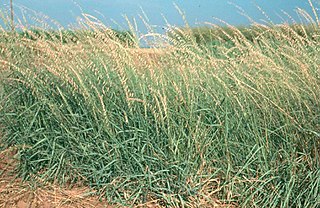
Bouteloua curtipendula, commonly known as sideoats grama, is a perennial, short prairie grass that is native throughout the temperate and tropical Western Hemisphere, from Canada south to Argentina.
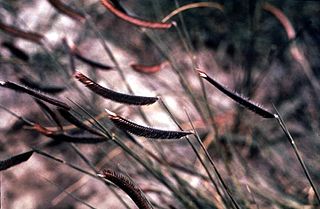
Bouteloua gracilis, the blue grama, is a long-lived, warm-season (C4) perennial grass, native to North America.

Bouteloua is a genus of plants in the grass family. Members of the genus are commonly known as grama grass.

Bouteloua dactyloides, commonly known as buffalograss or buffalo grass, is a North American prairie grass native to Canada, Mexico, and the United States. It is a shortgrass found mainly on the High Plains and is co-dominant with blue grama over most of the shortgrass prairie.

The yellow-nosed cotton rat is a species of rodent in the family Cricetidae. It is native to Mexico and to the states of Arizona, New Mexico, and Texas in the United States, where it inhabits mountain grassland, scrub, and pinyon-juniper woodland. It is common over much of its wide range and the IUCN considers it to be of "least concern".

Bromus secalinus is a species of bromegrass known as rye brome. The specific epithet secalinus is Latin, meaning "rye-like". The fruits are hard, rounded glumes that appear superficially similar to the rye grain, which gives the brome its common and scientific name. The grass has a diploid number of 28.
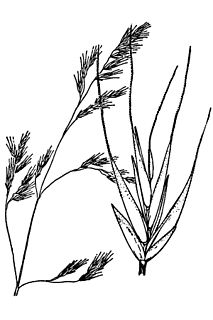
Festuca occidentalis is a species of grass known as western fescue. It is native to much of the northern half of North America and is most widely distributed in the west. It is most often found in forest and woodland habitat. The specific epithet occidentalis is Latin, meaning "western".

Bromus madritensis is a species of brome grass known by the common name compact brome. The specific epithet madritensis refers to Madrid, Spain. It has a diploid number of 28.

Bromus ciliatus is a species of brome grass known by the common name fringed brome. It is native to most of North America, including most of Canada, most of the United States except for some portions of the South, and northern Mexico. It is a plant of many habitats, including temperate coniferous forest. The specific epithet ciliatus is Latin for "ciliate", referring to the delicate hairs of the leaf blades.
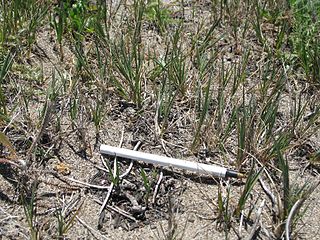
Agrostis pallens is a species of grass known by the common name seashore bentgrass. It is native to western North America from British Columbia to Montana to California, where it grows in many types of habitat, typically open meadows, woodlands, subalpine areas, and other dry habitats. The diploid number of the grass is either 42 or 56.

Bouteloua hirsuta, commonly known as hairy grama, is a perennial short prairie grass that is native throughout much of North America, including the Great Plains and Canadian Prairies region, as well as Mexico and Guatemala.
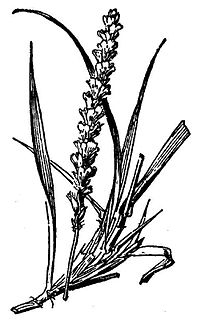
Pleuraphis mutica is a species of grass known by the common name tobosa, or tobosa grass. It is native to Northern Mexico, and the Southwestern United States, in Arizona, New Mexico, Oklahoma, and Texas.
Hypericum cuisinii is a perennial herb in the genus Hypericum, in the section Adenosepalum. The herb has pale yellow flowers and occurs in Greece and Turkey.

Festuca brachyphylla, the alpine fescue, is a grass native to Eurasia, North America, and the Arctic. The grass is used for erosion control and revegetation. The specific epithet brachyphylla means "short-leaved". The grass has a diploid number of 28, 42, or 44.
Festuca saximontana, the rocky mountain fescue or the mountain fescue, is a perennial grass native to North America. The specific epithet saximontana is Latin and means "of the Rocky Mountains". The grass has a diploid number of 42.

Bouteloua repens, colloquially known as slender grama, is a grass species in the grama genus native to the southwestern United States and northern Mexico.

Bouteloua radicosa, colloquially known as purple grama, is a grass species in the grama genus native to the southwestern United States and northern Mexico.

Bouteloua parryi, colloquially known as Parry's grama, is a grass species in the grama genus native to the southwestern United States and northern Mexico.

Bouteloua simplex, colloquially known as matted grama or mat grama, is a grass species in the grama genus native to much of the Americas.

















